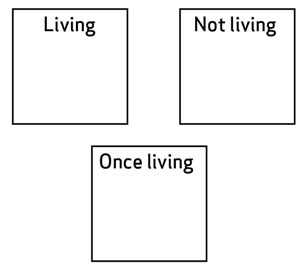2 What kinds of questions do students ask?
Now read Case Study 1.
Case Study 1: Mrs Das’s students raise questions to sort and classify objects
Mrs Das teaches 57 students in Class III. She is keen to help her students investigate the local environment and science using local resources. She explains how she set up a sorting activity and encouraged her students to ask questions about the objects.
I have always enjoyed doing practical activities with my class. I wanted to help them explore the difference between living and dead things, so I collected together a group of objects from around the classroom and outside. I also included a few pictures that I cut out of magazines of some animals. I prepared two labels (‘Living’ and ‘Not living’) and put these on the table in front of my students [Figure 1].

I worked with two groups of six students while the rest of the class did other tasks. I did this over two lessons with five groups in the first and the same in the second. I gave each pair of students one object and asked them to think what questions they wanted answered about their object. All of them suggested questions like:
- What is it?
- Is it a plant or animal?
- Where does it live?
- What does it eat?
- Is it real?
- Where did you find it?
- Is it dead?
- Is this living?
- Is it dangerous?
- Is it poisonous?
All of these were the sort of questions you would expect students of this age to ask. They were more focused on naming them and fitting the simple information into their current understanding and experience.
After they had all done the task I asked them if anyone could answer these questions. They could answer some but not others. Mostly they were able to name the objects, including most of the animal pictures but not as many of the plants and just a few of the other objects. Picking up on their question ‘Is it dead?’, I asked the students if they could sort the objects into living and not living.
All the students participated – even those who are normally very reticent to answer questions in whole-class discussions. I asked questions when the group struggled with its discussion, but otherwise I just listened. I asked one group why they had put a dead leaf into ‘Not living’ and the other group why they had put their dead leaf into ‘Living’. It was clear that they were confused about the leaf and so we discussed if it had ever been alive, and agreed in the end to add it to a new group labelled ‘Once living’.
My students found it easy to decide about a piece of metal but found a piece of cotton cloth difficult to group, as it had once been living and was now made into fabric. The discussion and their questioning helped my students to clarify their thinking about the difference between living and non-living things. Their curiosity was aroused by the interactive task.
Pause for thought How does such an activity help students to be more observant and curious, or ask more productive questions? |
1 Why students ask questions
